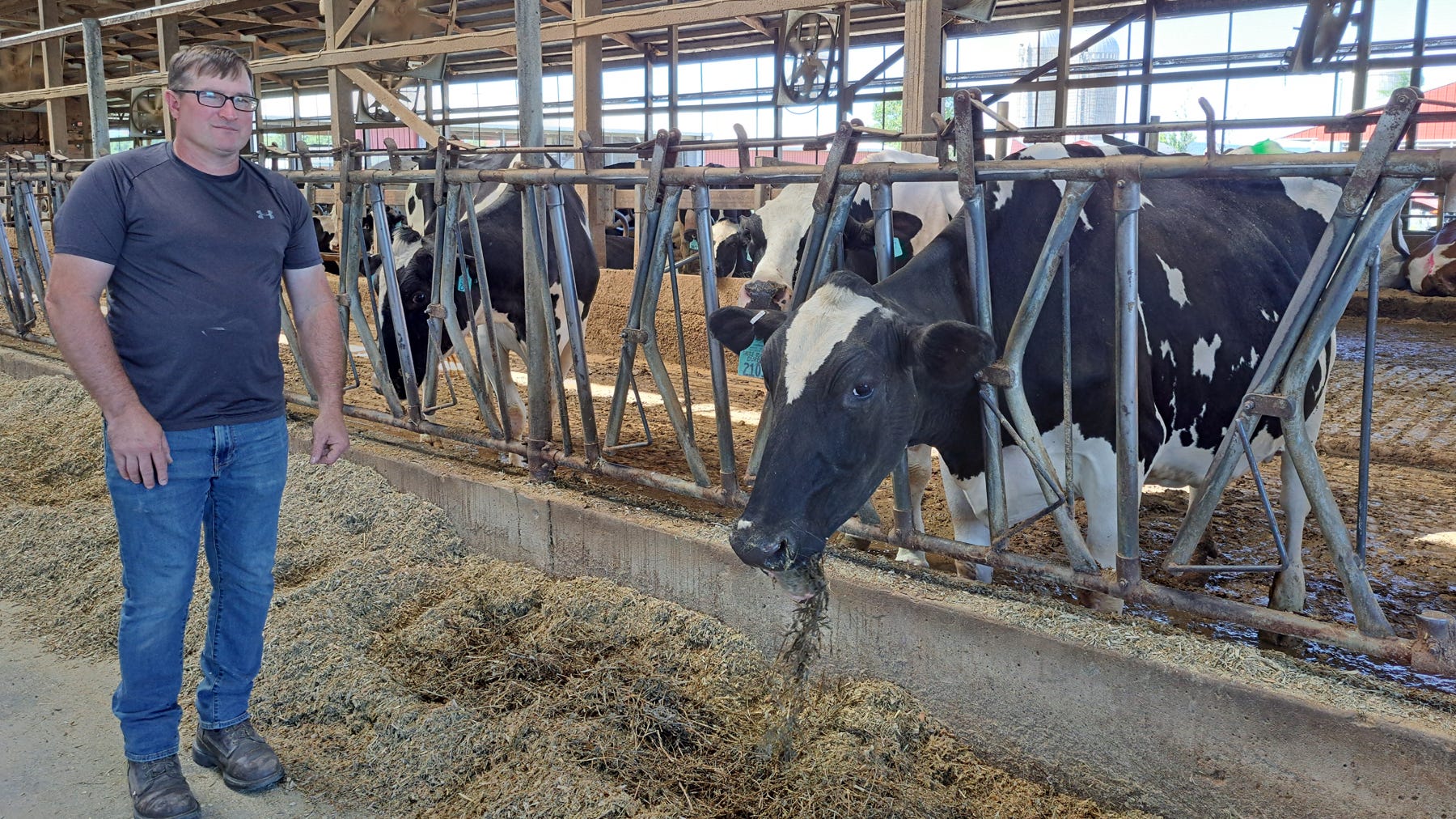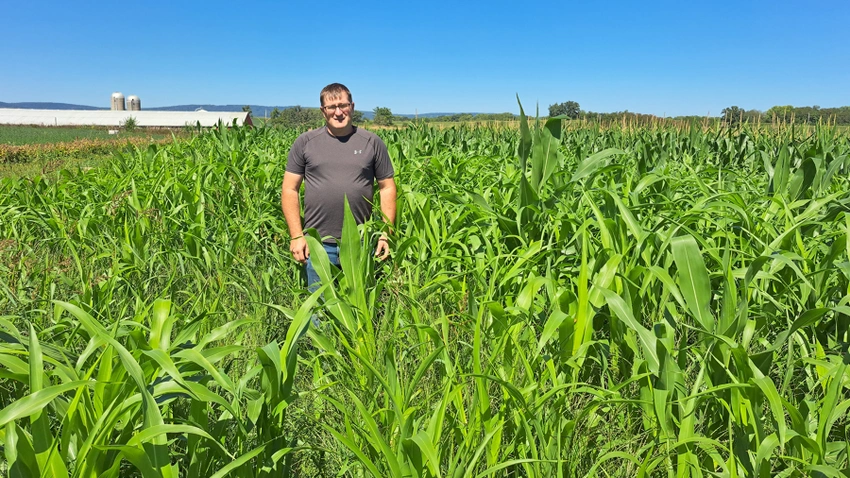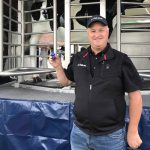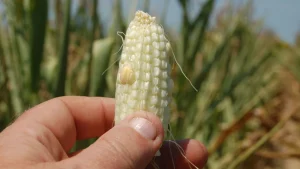
Dairy farmers discuss how they plan to feed their cattle in the wake of this summer’s dry conditions.
When Craig Carncross finished planting corn on May 16, he had no idea this was going to be a drought year, he says.
“We had a really wet April and first half of May,” the 47-year-old dairyman recalls. “We were just grateful to get the corn planted.”
But between May 14 and July 13, he received only 0.4 of an inch of rain on his family’s 520-acre dairy farm in the southwest corner of Columbia County, a mile south of Lake Wisconsin near Prairie du Sac, Wis.
“We tried planting our late-planted corn on May 28 after we harvested 40 acres of cover crops,” Carncross explains. “The ground was so hard we couldn’t plant. It rained 0.2 of an inch later that day, and it was enough for us to get the corn in the ground the next day.”
However, germination was delayed nearly two months. On June 24, he says it rained 0.2 of an inch.
“But that wasn’t enough moisture to germinate the corn,” he says. “We actually went out and spread liquid manure on the ground, but it was so dry, it just evaporated.”
The late-planted corn planted May 28 didn’t germinate until after it rained 1.25 inches on July 13. “The corn germinated and came up the next week,” Carncross says.
On July 28, they had a half-inch of rain. A total of 1.8 inches of rain fell during the month of August. But there was no rain through the first week of September. From May 14 through Sept. 7, a total of 3.95 inches of rain fell at the farm, which is less than one-third of the normal amount.

MULTIPLE MATURITIES: There are multiple stages of corn growth in the same field at Craig Carncross’s farm. These two ears of corn from his 40-acre field of late-planted corn illustrate the extremes.
U.S. Drought Monitor
According to the Wisconsin U.S. Drought Monitor, the western third of Columbia County where Carncross’s farm is located is in the red and is experiencing extreme drought. He is not alone. As of Sept. 8, 84% of the state of Wisconsin is seeing some level of drought, down from 92% in July.
Carncross grows corn, alfalfa and wheat for his 460 registered Holstein cows and 380 heifers.
“We have a lot of mouths to feed,” he says.
Carncross says his silage averaged only 12 tons to the acre this year.
“Our BMR corn silage averaged 25 tons to the acre from 2019 through 2022, and our regular corn silage averaged 28 tons per acre,” he says. In a normal year, he has the majority of his corn harvested by a custom harvester for silage and some high-moisture corn. His first-crop alfalfa yielded well, but his second, third and fourth cuttings averaged about half to less than half of what he normally harvests. Carncross does not plan to take a fifth cutting in October.
After his wheat was harvested in July, he seeded 38 acres of sorghum-sudangrass to help supplement his forage needs. In August, he purchased 25 acres of standing alfalfa from a neighbor. He also plans to buy about 100 acres of standing corn from a neighbor for silage.

DROUGHT IMPACT: Craig Carncross is planning to purchase 100 acres of standing corn from a neighbor to help make up his forage yield losses due to this year’s drought. He milks 460 registered Holstein cows and raises 380 Holstein heifers on his 520-acre Columbia County, Wis., farm.
Carncross is grateful he has crop insurance.
“We have had it every year since my dad [Gordon] and I expanded our herd in 2007,” he says. “I think crop insurance will help mitigate some of our losses, but it might only pay for half of the feed we have to buy.”
He thinks this year’s drought is more severe than the 2012 drought.
“I think it’s as bad as the 1988 drought,” he says.
Carncross is confident he will recover from this drought, but he has one fear.
“The scary thing is if we have a drought next year,” he says. “But I think we’re OK. We haven’t experienced back-to-back droughts.”
Carryover feed
Travis Marti, 40, and his wife, Melissa, are the third generation of his family to farm on the home farm near Vesper in Wood County, Wis. The Martis milk 565 Holstein cows. Their heifers are raised by a heifer grower. They farm 1,200 owned and rented acres in central Wisconsin, where they grow 650 acres of corn, 300 acres of soybeans and 250 acres of alfalfa.
“Normally this is enough land to raise all of our forages and most of our corn for grain,” Marti says. “We are fortunate enough to have feed carryover from last year, which is going to get us through winter. We had really good, high-yielding crops last year. That is something my dad and my grandpa taught me is to always have some feed in reserve. They farmed through some pretty tough years, and they learned that is important.”
Marti says he is grateful they had high-yielding crops last year to make up for this year’s shortfall.
“We normally fill up the bunkers with corn silage, and then we harvest the rest for grain,” he explains. “We are sitting on an inventory of corn silage from last year. I don’t like feeding green corn silage. We have haylage leftover from last year, too.”

CARRYOVER FEED: Travis Marti of Vesper, Wis., will make up for yield losses from this year’s crops by relying heavily on carryover feed that he still has from last year’s excellent crops. Marti milks 565 Holstein cows and farms 1,200 acres in Wood County. (Photo by Melissa Marti)
Marti says they had an excellent first crop of alfalfa in May this year, both quantity- and quality-wise.
“Our second crop was half of our expected yield — it was good quality but not as much as we would have liked,” he says. “Third crop was less than half of what we would have expected.”
Spotty rains
Marti says he has been frustrated much of the summer with rain missing their farm.
“We missed a lot of rains that have gone north or south of us,” he says. “I figure we had 5 to 6 inches of rain for the entire summer between May 14 and Sept. 8. It seems like it has been so spotty. Someone 10 miles north of us would get a good shower, and it missed us. Overall, we were very dry all summer. I would say we are as dry or drier than we were in 2012.”
According to the U.S. Drought Monitor from Sept. 8, the Marti’s farm is located in severe drought, which is orange on the map below. They have crop insurance, but Marti says he is unsure if they will get a claim on their yield losses for their corn. However, the soybeans didn’t handle the dry weather as well as the corn, and he does expect some kind of payment.

DROUGHT MONITOR: This map shows conditions in Wisconsin as of Sept. 8. The top dot marks Wood County, where Travis Marti farms. The bottom dot marks Columbia County, where Craig Carncross farms.
“In 2013, we had a claim from prevent plant acres because it was so wet,” he says. “Our corn silage is quite variable. Some of the later-planted corn looks pretty good, but some of it looks rough. We have been running on the edge of extreme drought all growing season. Typically, we have soils that hold water real well — but not this year. This is something different for us.”
Marti says they plant a lot of cover crops, usually rye, but they haven’t needed to harvest cover crops for feed.
“We will plant 500 acres of cover crops this fall,” he says “If we needed to, we could harvest them for feed, but generally they are just cover crops.”
Marti says he chops his own corn silage and haylage. “The hot weather we got the first week of September just shut some of our corn down,” he says. “So, we chopped that first.”
He is not sure if he will take a fourth cutting of alfalfa in October.
“Typically, we take four cuttings of alfalfa, but I don’t know that there will be enough to justify harvesting a fourth crop this year.”
























